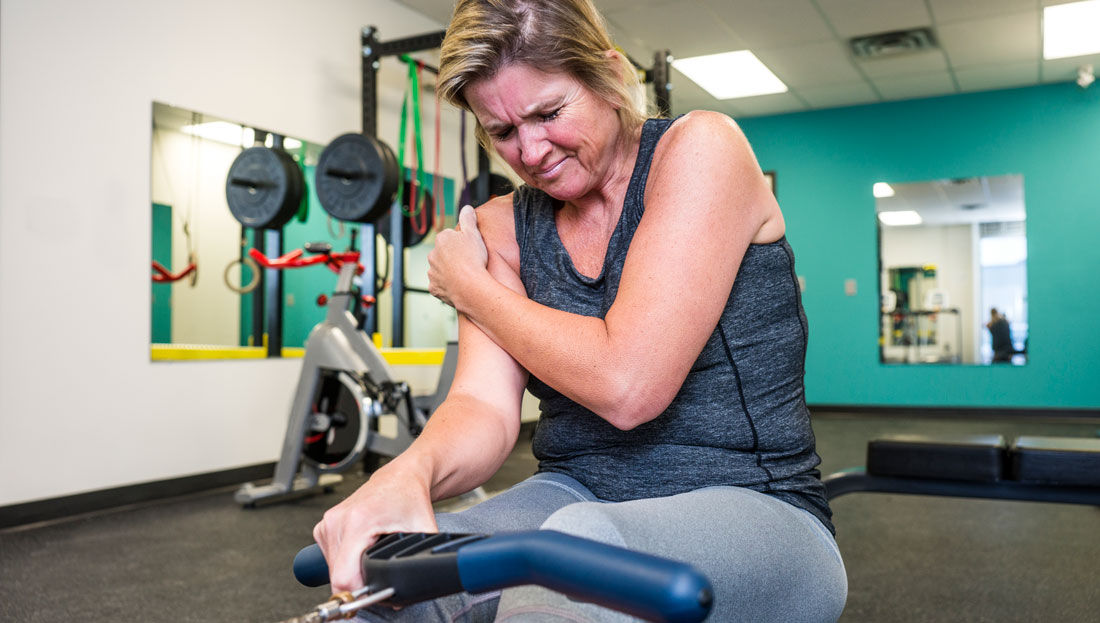
Few things can more quickly derail a client’s ability and desire to achieve his or her fitness goals than an injury. And as a health and exercise professional, those same injuries can be a significant obstacle to your ability to maintain a consistent income. Before you—and your clients—assume they can’t train while injured or keep progressing toward their goals, here are a few things worth taking into consideration.
Over the years, I’ve had clients with sprains, strains, tendinitis, broken appendages, surgical repairs, overuse injuries…the list is long. Early on in my career, if a client presented with an injury, we put all training on hold. After experiencing my own share of injuries and surgical repairs, however, I realized it is very possible to continue training other areas of my body while still allowing the injury to heal.
“Almost all injuries can be worked around, unless contraindicated by a medical professional,” says Evan Chait, a physical therapist and co-founder of Kinetic P.T. in N.J. “The key is to continue moving, even after an injury. Moving painlessly is the number one goal.”
“At the inflammation stage of any injury, rest is needed first,” advises J.J. Flizanes, director of Invisible Fitness and author of The Invisible Fitness Formula: 5 Secrets to Release Weight and End Body Shame. “Once the doctor has approved movement, all injuries can be worked around, depending on where they are and what you want to do. If you are able to get up and walk around, you can do simple body-weight movements with the unaffected parts.”
Chris Finn, P.T., C.S.C.S., founder of Par4Success, agrees. “The key to working with a client when they have an injury of a specific local area, such as a shoulder or knee, is to identify all of the other patterns they can train without negatively impacting the area involved. This may even assist with their recovery.”
Joanne Donoghue, Ph.D., a registered exercise physiologist and assistant professor at NYIT College of Osteopathic Medicine, uses the example of how devastating an ankle injury can be to a runner. “But a trainer can focus on core strength, upper-body conditioning and flexibility. All these things can improve performance while forcing the usual muscles that work overtime during running to take a much-needed rest.”
In fact, says, Donoghue, a trainer should explain to his or her client how rest can be the best ally for healing an injury. “It is a forced recovery and allows athletes [and clients] to rest overused muscles and explore different modes of training. Additionally, adds Donoghue, “As for lower-body injuries, such as [to the] knees and hips, pool running is a fantastic alternative.”
Perhaps the most common ailment your clients are likely to experience is back pain. The good news is that, according to the National Institute of Neurological Disorders and Stroke, most acute lower-back pain improves over time without medical treatment. “Exercise therapy,” explains Donoghue, “can be very therapeutic to acute pain when performed correctly. Just pedaling a stationary bike can help bring blood flow to painful muscles and help loosen tight muscles. Another example may be a swimmer who suffers an upper-body injury [that requires rest]. In this case, cycling may strengthen the lower body [and provide some cardio exercise].”
“When I have someone with a strained or sprained ankle,” says Kit Mathews, a certified Pilates teacher in Denver, Colo., “I tend to avoid weight bearing of the lower body until the injury is healed. Exercises that are safe and still work the rest of the body, such as core work, upper body, side body and back can help to keep the client strong and his or her spine flexible without risking a setback in the healing process.”
Proceed With Caution
Before you go contacting your injured clients, take a moment to consider each individual situation. Is this an acute injury? Is it a chronic condition caused by an old injury? Is he or she supposed to be resting, icing, compressing and elevating (R.I.C.E.) the injury?
If you haven’t already, make sure you read this CERTIFIED article about medical fitness. It includes tips on creating your own medical fitness network and how to work with other professionals involved in your clients’ care.
All of the experts consulted for this article strongly stressed that a client should first receive medical clearance to exercise. Finn suggests identifying and establishing a relationship with a medical professional who can help you differentiate between issues that require medical attention versus those that can be managed conservatively while still remaining engaged in a fitness program. “Oftentimes,” explains Finn, “rehabilitation can be incorporated into the fitness routine, keeping the clients engaged, revenue continuing to come in and the client recovering faster."
If your client is seeing or has seen a physical therapist for the injury, he or she can be your go-to. “I would highly suggest the fitness professional contact the physical therapist and co-create a training program that is safe and effective,” says Chait.
Mathews agrees. “I highly encourage trainers to ask the client’s permission to join him or her at an appointment with the physical therapist…to learn what the client has been doing [during rehab].”
This also provides the health and exercise professional with clear boundaries for contraindicated exercises. Take, for example, an individual who is recovering from ACL reconstruction knee surgery. “The patient is in a brace with strict restrictions on how much to flex the knee and how much weight bearing he or she can load on the leg. In this case, even attempting to do core exercises may activate [synergistic] muscles that should not be moved at this time. The risk does not outweigh the benefits,” says Donoghue.
When Rest Is Best
While many injuries can be worked around, there are some that simply require full rest, at least for a certain length of time.
“Especially in the case of surgery, many physicians will require a recovery period of a few weeks when the patient will need to rest,” says Donoghue. “After that time, if the physician has determined that exercise will not negatively impact the site, then the client may be able to perform certain exercises. A trainer should not attempt to perform any exercise post-surgery without clearance from the physician who performed the surgery.”
Donoghue also points out that concussions and other brain injuries are definite contraindications to any exercise. “Long periods of rest are mandatory so as to allow the brain to heal and not further aggravate the injury. During this time, the clients should refrain from exercise, as the brain is at an increased risk of swelling, and inflammation and damage sustained could be life long.”
It’s important to note, too, that clients should not be driving while on certain pain medications, so if they have to come to you, they should be off these meds. If clients can get a ride to you or if you go to them, it is still important to note that many pain medications have the potential to cause dizziness and loss of balance. Therefore, combining these medications with exercise increases the risk of injury and would be contraindicated, as well.
As with anything you do with your clients, common sense is key. Know your scope of practice and obtain medical clearance to continue working with your client when an injury arises. Continue to educate yourself in these areas and use your network of other professionals to increase your experience and knowledge base.
“Fitness professionals should be the first line of defense in our healthcare system,” concludes Finn. “The better equipped they are with the understanding of how muscle and referral pains work, the better prepared they are to help clients with an ache or pain and keep them working out to reach their goals.”
Signs Your Client Is Overdoing It
Communication between you and your client while working around an injury is crucial, as is constant feedback. Ask your client often how each exercise feels. Watch for signs of distress in his or her face, as well as for signs of inflammation or a change in color at the injury site.
“And if the pain is not improving over a two- to four-week period or it’s getting worse, you’re overdoing it,” cautions Chait. “When in doubt, refer out!”





 by
by 


